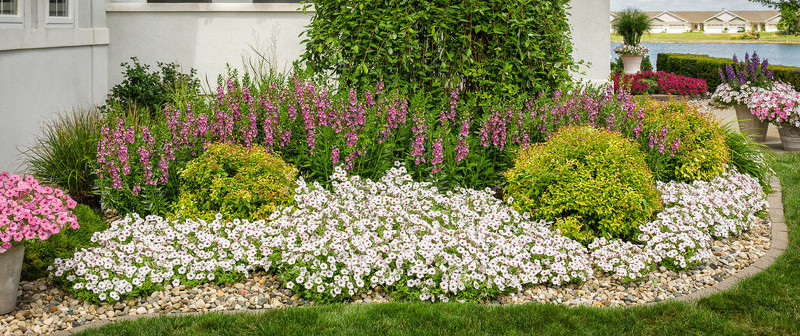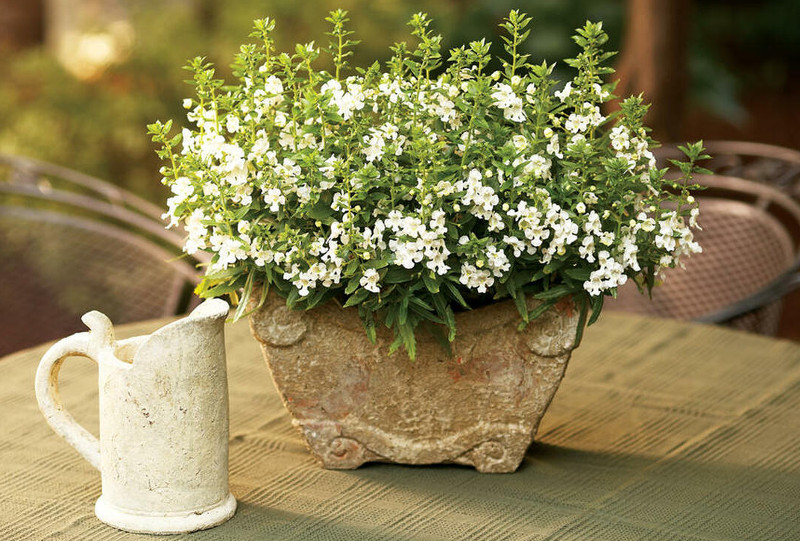Antirrhinum is a genus of plants commonly known as dragon flowers or Snapdragons because of the flowers' fancied resemblance to the face of a dragon that opens and closes its mouth when squeezed or when a bee lands on the curved flower lip. They are native to rocky areas of Europe, the United States, and North Africa.
Common garden Snapdragons (Antirrhinum majus) bloom from April to frost. Grown as a perennial in USDA zones 9-11, this plant is considered an annual in other areas. Six hours or more of sun is what makes this plant bloom well. Dwarf Snapdragons are the most common of the species being 6-10 inches tall and 10-12 inches high.
Blooming in colors white, yellow, pink, red, orange, peach, purple and violet. The vibrant colors are a great addition to mass plantings, landscapes, borders, or containers.

Planting Snapdragons
It is best to plant Snapdragons after the threat of frost has passed. Choose a location that will get 6 hours of full sun each day. Snapdragons like rich, well-drained moist soil. Space each plant 6-12 inches apart in the garden area. Prior to planting, amend the soil with some compost. Water the plant thoroughly after planting.
Watering Snapdragons
After initial planting, it is best to keep the tender plants moist for the first few weeks. Once established, regular watering of one inch per week is recommended. Water near the crown of that plant and avoid getting the foliage wet. For best results, avoid overwatering. Allow the soil to completely dry out in between waterings. A good rule of thumb is if the top one inch of soil feels dry to the touch.

Fertilizing Snapdragons
Snapdragons do not require fertilizer when newly planted. It is best to wait until the plant begins to produce flowers before the first application. Use a standard 10-10-10 fertilizer for every 100 square feet of flower bed. Water well after application to prevent nitrogen burn, as well as to help the food to reach the roots. During bloom time, fertilize monthly.
Pruning Snapdragons
Regular pruning of Snapdragons will encourage new growth and help with a longer blooming time. Once blooms have died off, pinch off the spent flower to help with development of new flowers. If you do not deadhead the spent flowers, the Snapdragon will go to seed. As needed, snip off any dead foliage.

Caring For Snapdragons in Pots
Snapdragons can be easily grown in a container. Choose a large container with drainage holes. This plant will require regular watering, but be careful not to overwater it. Snapdragons prefer 6 hours of full sun each day. As the snapdragon flowers die off, pinch off the spent blooms to encourage flower production.
Snapdragons For Sale
Common Snapdragons Care Questions
What Time Of Year Do Snapdragons Bloom? Do They Bloom All Summer?
In cooler climates, snapdragons do bloom all summer and sometimes during the winter months, too! They can bloom all summer in warmer climates but generally do better in the spring and fall, when temperatures are a bit cooler. While they are technically perennials, they are usually treated as annuals.
Are Snapdragons Low-maintenance?
These fast-growing, short-lived perennials (averaging a three-year life span) are very low maintenance. With only the right amount of sunshine and moisture, they will thrive. They will benefit and blooms are more abundant with some deadheading, also.
Do Snapdragons Spread?
Snapdragons will spread by seed traveling on the winds! If you don't want them to spread, you'll need to be vigilant about deadheading (removing spent blooms) before the seeds are set on.
Are Snapdragons Annual Or Perennial?
There are varieties of snapdragons that are annuals, and some varieties that are perennials. Though the perennial varieties are generally short-lived, lasting only a few years.
Are Snapdragons Annual Or Perennial?
There are varieties of snapdragons that are annuals, and some varieties that are perennials. Though perennial varieties are generally short-lived, lasting only a few years.
Do Snapdragons Like Sun Or Shade?
Snapdragons prefer full sun but will tolerate a bit of shade.
Do Snapdragons Come Back Every Year?
Technically, snapdragons are perennials, albeit short-lived perennials, and are generally planted as annuals.
What Is The Height Of A Snapdragon?
Snapdragons have come in a wide range of heights. There are dwarf varieties that only get 4 to 6 inches tall and there are varieties that can reach up to 30 inches high, and many varieties in between.
What Are The Colors Of A Snapdragon?
Snapdragons come in a huge range of colors, from yellows and oranges to pinks and reds, burgundy, bronze, and white. There are even multicolored varieties!
Are Snapdragons Drought Tolerant?
Snapdragons are definitely very drought tolerant, though blooming will be better with regular watering through the summer.
What Is The Growth Rate Of A Snapdragon?
Snapdragons are very fast growers, often reaching their mature size within a matter of just a few weeks.
Have a question about Snapdragons? Fill out the form below and we will try and get back to your question as soon as possible. We may even feature your question on this article to help other gardeners!
 |
Author Chris Link - Published 08-02-2021 |
